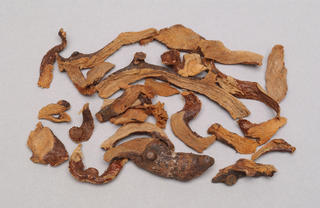Drynaria fortunei
Contents
Nomenclature
Other Names:
Historical Use of Drynaria fortunei
Drynaria fortunei in Traditional Chinese Medicine
Background
Chinese Name (pinyin): Gusuibu
Chinese Name :
Common Name :Drynaria Rhizome
Specific Name : Rhizoma Drynariae
Scientific Name:
Collection : The drug is collected all year round, removed from soil and dried or hairs (rameta) also removed.
Description : Flattened long slat shaped, mostly curved, branched, 5 - 15 cm long, 1 - 1.5 cm wide, 2 - 5 mm thick. The surface closely covered with deep brown to dark brown hair like ramenta and brown or dark brown when burnt, upper surface and both sides marked by raised depressed circular frond, scars, rarely by fond bases and remains of fibrous roots. Texture light, fragile, fragile, easily broken, fracture reddish brown, vascular bundles yellow dotted and arranged in a ring. Odourless taste weak and slightly astringent.
Identification : Heat under reflux 0.5 g of the powder in 30 ml of methanol for 1 hour, cool and filter. Evaporate the filtrate to dryness and dissolve the residue in 1 ml of methanol as the test solution. Dissolve naringin CRS in methanol to produce a solution containing 0.5 mg per ml as the reference solution. Carry out the method for thin layer chromatography (Appendix Vl B), using silica gel G as the coating substance and the upper layer mixture of benzene-ethyl acetate-formic acid-water (1:12:2.5:3) as the mobile phase. Apply separately 4 µl of each of the two solutions to the plate. After developing and removal of the plate, dry it in the air. Spray with aluminum chloride TS and examine under ultra violet light (365 nm). The fluorescent spot in the chromatogram obtained with the test solution correspond in position and color to the spot in the chromatogram obtained with the reference solution.Assay: Carry out the method for high performance liquid chromatography (Appendix Vl D)Chromatographic system and system suitability. Use octadecysilane bonded silica gel as the stationary phase and methanol acid acetic water (35:4:61) as the mobile phase. Thew wavelength of the detector is 283 nm. The number of theoretical plates of the column is not less than 3000, calculated with the reference to the peak of naringin.Preparation of reference solution: Weigh accurately 20 mg of naringin CRS, dried to constant weight at 110ºC in a 10-0 ml volumetric flask, dilute with methanol to volume and mix well. Accurately measure 3 ml in 10 ml volumetric flask, dilute with methanol to volume and mix well (containing 60 µg of naringin per ml).Preparation of test solution: Weigh accurately 0.25g of the coarse powder [perform a determination of water ( Appendix lX H, method 2), add 30 ml of methanol, heat under reflux on a water bath for three hours, cool, and filter. Transfer the filtrate to a 50 ml volumetric flask, wash the container with a small quantity of methanol for several times, filter the washings to the same flask, dillute the methanol to volume, and mix well. Procedure: Inject accurately 10 µl of each of the reference solution and the test solution into the column, determine and calculate the content. It contains not less than 0.5% of naringin (C27H32O14&2H2O) on the dried basis.
Processing : Eliminate foreign matter, wash clean, soften thoroughly, cut into thick slices and dry.Rhioma Drynariae (scalding): Scald the clean Rhizoma Drynariae of its slices with sand as drescribed under the method for scalding ( Appendix ll D) until inflated and strike to remove hairs.
Action :
Indication : deficiency syndrome of the kidney marked by back pain, tinnitus, impairment of hearing, loosness of teeth; traumatic injury, bone fracture
external: alopecia areata, vitiligo
Precautions :
Dosage :
Storage :
Synonymns for Drynaria fortunei
Patent Medicines and Medicines with Multiple Ingredients that include Drynaria fortunei
Pharmaceutical Information
Chemical Constituents
Evidence or the Use of Drynaria fortunei in the Treatment of Epilepesy
Basic Science
Animal Studies
Cohort, Case-Control and Non-Randomized Trials
Randomized Controlled Trials
Meta-Analysis
1st Five Results: pubmed search
Yuxiao Zhao, Xiaofang Cai, Jian Sun, Wei Bi, Youcheng Yu
Active components and mechanisms of total flavonoids from Rhizoma Drynariae in enhancing cranial bone regeneration: An investigation employing serum pharmacochemistry and network pharmacology approaches.
J Ethnopharmacol: 2024, 319(Pt 3);117253
[PubMed:37778522]
[WorldCat.org]
[DOI]
(I p)
Lan Xie, Shuai Zhao, Xiaoling Zhang, Wenting Huang, Liansheng Qiao, Delin Zhan, Chengmei Ma, Wei Gong, Honglei Dang, Hua Lu
Wenshenyang recipe treats infertility through hormonal regulation and inflammatory responses revealed by transcriptome analysis and network pharmacology.
Front Pharmacol: 2022, 13;917544
[PubMed:36003498]
[WorldCat.org]
[DOI]
(P e)
Cheng-Huan Peng, Wen-Ying Lin, Chia-Ying Li, Kameshwara Kumar Dharini, Chih-Yu Chang, Jo-Ting Hong, Ming-Der Lin
Gu Sui Bu (Drynaria fortunei J. Sm.) antagonizes glucocorticoid-induced mineralization reduction in zebrafish larvae by modulating the activity of osteoblasts and osteoclasts.
J Ethnopharmacol: 2022, 297;115565
[PubMed:35863613]
[WorldCat.org]
[DOI]
(I p)
Lin Lu, Zhi Wang, Hanqing Zhang, Tongou Liu, Hong Fang
##Title##
Gynecol Endocrinol: 2022, 38(2);176-180
[PubMed:34907823]
[WorldCat.org]
[DOI]
(I p)
Li Guan, Xingyu Huang, Huiru Zhao, Weize Li
The optimization of total flavonoids from rhizoma drynariae by response surface methodology and the metal ion chelation activity assay.
Pak J Pharm Sci: 2021, 34(2);621-627
[PubMed:34275838]
[WorldCat.org]
(I p)
